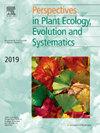Polyploidisation and niche differentiation drive the diversification of the Euphorbia epithymoides group (Euphorbiaceae) in southeastern Europe
IF 3.5
3区 环境科学与生态学
Q1 ECOLOGY
Perspectives in Plant Ecology Evolution and Systematics
Pub Date : 2024-09-08
DOI:10.1016/j.ppees.2024.125825
引用次数: 0
Abstract
Species groups spanning large areas of southeastern Europe gained little attention in phylogenetic studies. We here inferred relationships within the Euphorbia epithymoides group, distributed across the Balkan Peninsula, the southeastern margin of the Alps, the Pannonian Basin, and the Carpathians, and explored how polyploidisation is related to environmental niche differentiation. We used an integrative approach, including phylogenetic analyses (AFLP fingerprinting, ITS sequencing), estimates of ploidy level based on relative genome size, multivariate morphometrics, environmental niche analyses and species distribution modelling. Dating analyses inferred the origin of the E. epithymoides group at the Miocene/Pliocene boundary. Environmental changes facilitated the main divergence within the group, leading to the polyploid origin of E. fragifera and its niche contraction to a warmer Mediterranean climate. Within the more widespread and mesophyllous E. epithymoides s.l., the main genetic divergence, although with considerable geneflow, occurred in the central Balkan Peninsula. It was not accompanied by pronounced morphological differentiation, but rather by significant divergence of genome sizes and environmental niches. Our results corroborate the niche shift hypothesis as one of the powerful mechanisms for overcoming the minority cytotype exclusion after polyploidisation. Distribution modelling highlights the importance of the southern and eastern Balkan Peninsula and the adjacent Carpathians for the large-scale long-term survival and persistence of mesophilous (forest) vegetation throughout the Pleistocene. With exception of distinct E. fragifera, all other taxa (E. epithymoides, E. gregersenii, E. lingulata) should rather be considered subspecies of widespread, morphologically and ecologically variable E. epithymoides.
多倍体化和生态位分化推动了欧洲东南部大戟科大戟属植物的多样化
在系统发育研究中,横跨欧洲东南部大片地区的物种群很少受到关注。在此,我们推断了分布于巴尔干半岛、阿尔卑斯山东南缘、潘诺尼亚盆地和喀尔巴阡山脉的大戟科(Euphorbia epithymoides)物种群内部的关系,并探讨了多倍体化与环境生态位分化之间的关系。我们采用了一种综合方法,包括系统进化分析(AFLP 指纹、ITS 测序)、基于相对基因组大小的倍性水平估计、多元形态计量学、环境生态位分析和物种分布建模。年代分析推断 E. epithymoides 群起源于中新世/上新世边界。环境的变化促进了该类群内部的主要分化,导致 E. fragifera 的多倍体起源及其生态位收缩到气候更温暖的地中海地区。在分布更为广泛的中叶E. epithymoides s.l.中,主要的遗传分化发生在巴尔干半岛中部,尽管有相当多的基因流动。这并没有伴随着明显的形态分化,而是基因组大小和环境生态位的显著分化。我们的研究结果证实了生态位转移假说是克服多倍体化后少数细胞型排斥的有力机制之一。分布模型凸显了巴尔干半岛南部和东部以及邻近的喀尔巴阡山脉在整个更新世期间对中亲水性(森林)植被的大规模长期生存和持续存在的重要性。除了独特的 E. fragifera 外,所有其他分类群(E. epithymoides、E. gregersenii、E. lingulata)都应被视为广泛分布、形态和生态多变的 E. epithymoides 的亚种。
本文章由计算机程序翻译,如有差异,请以英文原文为准。
求助全文
约1分钟内获得全文
求助全文
来源期刊
CiteScore
6.50
自引率
0.00%
发文量
28
审稿时长
67 days
期刊介绍:
Perspectives in Plant Ecology, Evolution and Systematics (PPEES) publishes outstanding and thought-provoking articles of general interest to an international readership in the fields of plant ecology, evolution and systematics. Of particular interest are longer, in-depth articles that provide a broad understanding of key topics in the field. There are six issues per year.
The following types of article will be considered:
Full length reviews
Essay reviews
Longer research articles
Meta-analyses
Foundational methodological or empirical papers from large consortia or long-term ecological research sites (LTER).

 求助内容:
求助内容: 应助结果提醒方式:
应助结果提醒方式:


